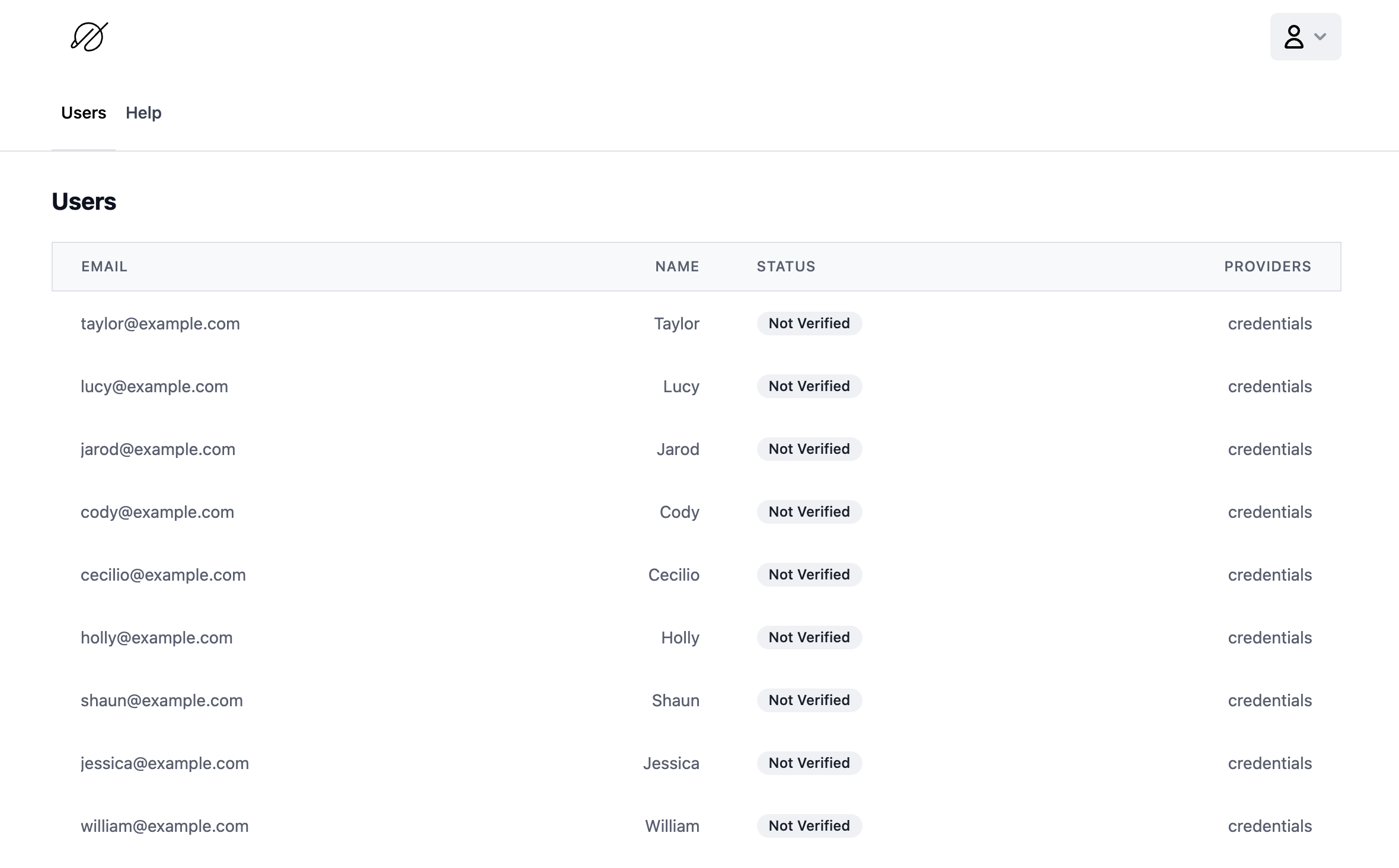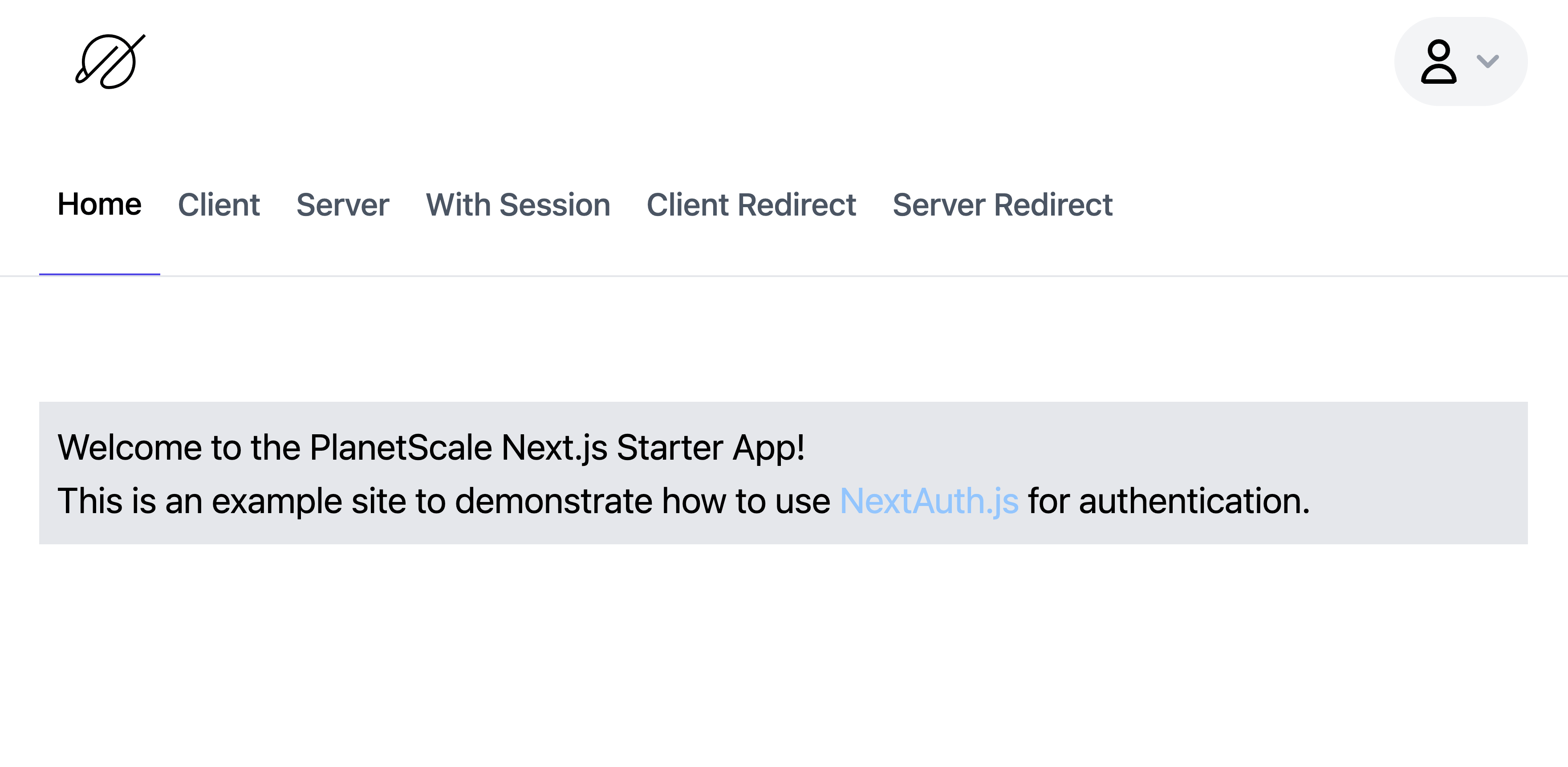Overview
This guide will show you how to get up and running with the Netlify, Next.js, and PlanetScale starter template. The template includes the following features:- Simple user admin dashboard
- PlanetScale database
- Prisma ORM integration
- Next.js authentication
- One-click deploy to Netlify
- Tailwind CSS styling

If you’re coming from the Netlify Template and you already clicked deploy, you’re in the right place! This tutorial will walk you through how to set up your PlanetScale database so that you can fill in the environment variables in the Netlify dashboard. You’ll also learn how to set up your local environment so you can continue to develop and extend this starter template. Just read through the prerequisites and then skip the first section to go straight to the local setup.If you’re starting fresh and haven’t deployed yet (or don’t want to deploy), you can start from the beginning of this tutorial.
Prerequisites
To follow along with this guide, you’ll need the following:One-click deploy to Netlify
The one-click deploy button allows you to connect Netlify to your GitHub account to clone thenextjs-planetscale-starter repository and automatically deploy it. Be sure to sign up for a Netlify account before clicking the deploy button.
 Once you click the button, you’ll be taken to Netlify’s direct deploy page with the pre-built project’s repository passed as a parameter in the URL. Click the “Connect to GitHub” button to authorize access.
Next, you’ll be asked to configure your site variables. For the
Once you click the button, you’ll be taken to Netlify’s direct deploy page with the pre-built project’s repository passed as a parameter in the URL. Click the “Connect to GitHub” button to authorize access.
Next, you’ll be asked to configure your site variables. For the Secret value, navigate to https://generate-secret.now.sh/32 to generate a secret and then paste that in. You can leave the Database URL and NextAuth URL values blank for now. Click “Save & Deploy”.
Your site will take about a minute to build and then you’ll be taken to a settings page. A unique Netlify URL will be generated for the project. You can click that now to see your live site! The next section will show you how to set the project up locally and create your PlanetScale database to connect to your live site.
Set up the project locally
If you already went through the Netlify deployment, find the repository that was created for you in your GitHub account and clone it. If you didn’t deploy and just want to run the template locally, you can clone thenextjs-planetscale-starter repository.
Enter into the folder and install the dependencies:

Database setup
Next, you need to set up your PlanetScale database. If you don’t already have a PlanetScale account, you can sign up for a free one here.Create your database
To begin, create a new database. You can either do this in the dashboard or using the PlanetScale CLI. In the dashboard, click on the “Create a database” button. Name your database “netlify-starter”, or whatever name you wish. Select the region closest to you, and click “Create database”.
Alternatively, sign in and create a database with the CLI by running the following:
Connect to your database branches locally
To connect locally, make sure you’ve authenticated in the CLI. If not, follow the directions in the sign-in section of our quickstart guide. Next, connect to yourmain branch locally by running the following in your terminal:
3309. You’ll see the response “Secure connection to database netlify-starter and branch main is established!” along with the local proxy address for your database. Take note of that address for the next step.
Set up local environment variables
For the last part of setup, you need to fill in your environment variables. Make a copy of the.env.example file at the root of your project and rename it .env:
DATABASE_URL value comes from your PlanetScale database and will be in the following form:
mysql://<user>@<address>:<port>/<database>
user— the database useraddress— the local address returned in the previous stepport— the port you specified in the previous stepdatabase— the name of your database
.env file based on this tutorial:
Push your database schema to PlanetScale
Now that your PlanetScale database is connected to your application, it’s time to push your database schema. In your terminal, run:netlify-starter database > “Branches” > main > “Schema” > “Refresh schema”.
You’ll now see the following tables:
AccountSessionUserVerificationToken
netlify-starter is your database):
exit to exit the MySQL shell.
The database schema, db/schema.prisma, has been loaded and your PlanetScale database is now ready for data.
Seed the database
To seed the database with users, run the following:User database, as described in db/seed.ts. To verify that they were added, click on the “Console” tab in your PlanetScale dashboard on the main branch of your netlify-starter database.
Run the following:
pscale shell command mentioned above.
Netlify environment variables
Now that you have your site running locally, let’s shift back to the live Netlify site. The final step in the site deployment is configuring your production environment variables. In the Netlify dashboard under your site’s settings page, click on “Build & deploy” > “Environment” in the left nav. Click on the “Edit variables” button and enter in the following key/value pairs:DATABASE_URL— To find this value, go back to your PlanetScale dashboard, click on thenetlify-starterdatabase, click “Connect”. If the password is masked and you don’t have one, you may click the “Generate new password” button to create a new one. Next, click on the “General” dropdown in that modal and select “Prisma”. Copy the value forurland paste that back in the Netlify dashboard as the value forDATABASE_URL. Be sure to save your PlanetScale password somewhere as you won’t be able to access it again after closing the modal.NEXTAUTH_SECRET— You may have already filled this out, but if not generate a new secret at https://generate-secret.now.sh/32 and paste in the value that’s returned.NEXTAUTH_URL— Paste in the Netlify site name that was generated for you. For example,https://stoic-lumiere-6df10.netlify.app
Set up your admin account
Now that your site is live and connected to your PlanetScale database, you need to set up your admin account for your application. Go to/admin/setup on your live Netlify site (or locally if you didn’t deploy), and fill in the form to set up your account. This will be automatically saved to your PlanetScale database.
Creating an admin account gives you access to the /admin route in your application, which is the dashboard to manage your users.
Once you’re signed in as an admin, navigate to /admin to see a list of your users.
Customize and extend
And that’s it! If you followed this tutorial completely, you now have a local and production version of your Next.js + PlanetScale + Prisma admin dashboard. So what’s next? Now, it’s time to extend it! Next.js Authentication is baked into this starter, so you can explore the Next.js docs to manage authentication in your application. You also have a fully functional PlanetScale MySQL database built for scale using the power of Vitess. You might have noticed that this tutorial uses the same database locally as it is in production. This was just for simplicity, but with PlanetScale, you can take advantage of our powerful branching feature to create development branches of your database specifically for testing locally. All you have to do is create a new branch and swap out theDATABASE_URL environment variable in your local .env file.
Finally, you have Prisma ORM already configured in your application. If you want to add any more fields to your User table or create any new tables, Prisma makes it easy with the schema.prisma file. If you want to make any schema changes, it’s a perfect time to try out the PlanetScale branching feature feature. If you mess up, those changes won’t touch production. And once you’re satisfied with the changes, you can deploy to production without causing downtime thanks to PlanetScale non-blocking schema changes.
Hopefully this tutorial has been helpful. We’d love to hear how you’re extending your starter application. Tweet us @PlanetScale and share what you built!

